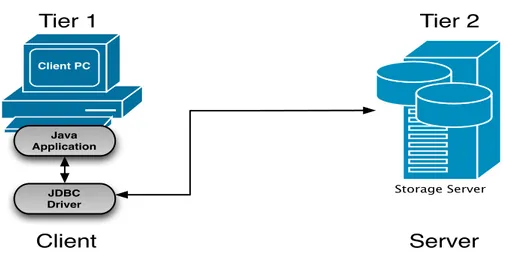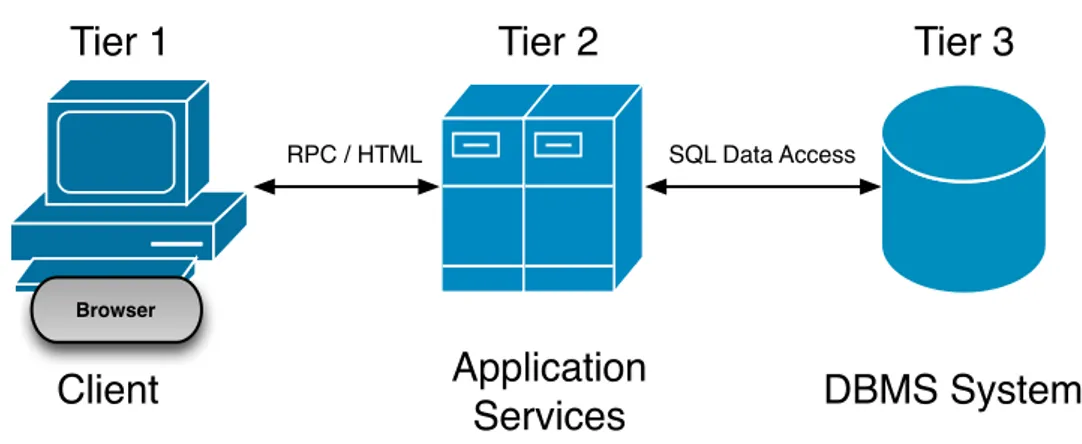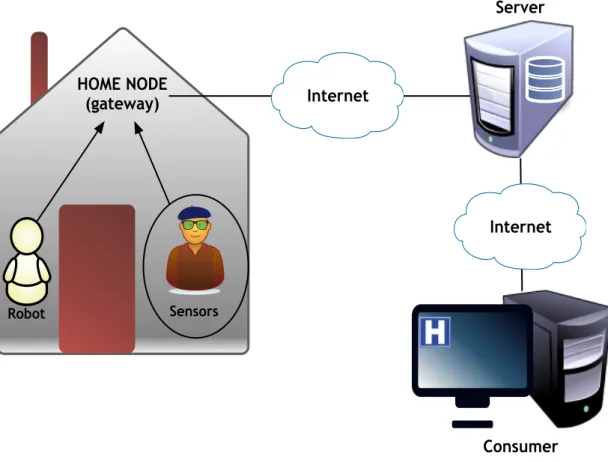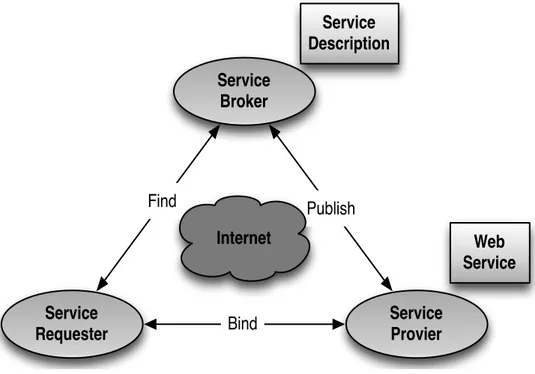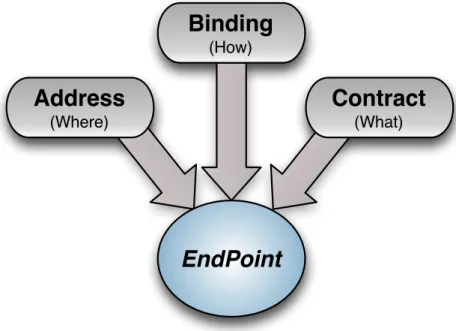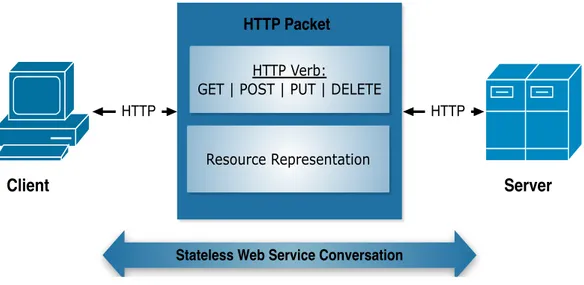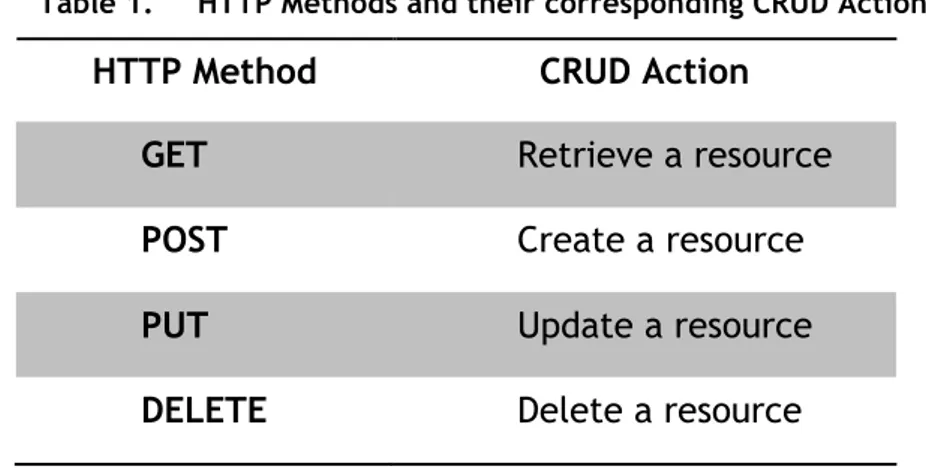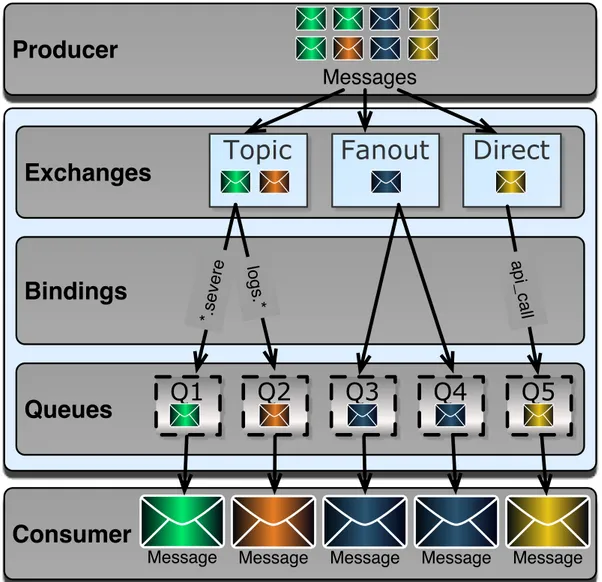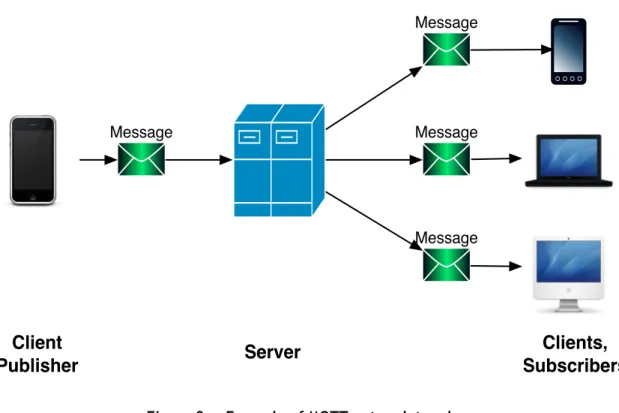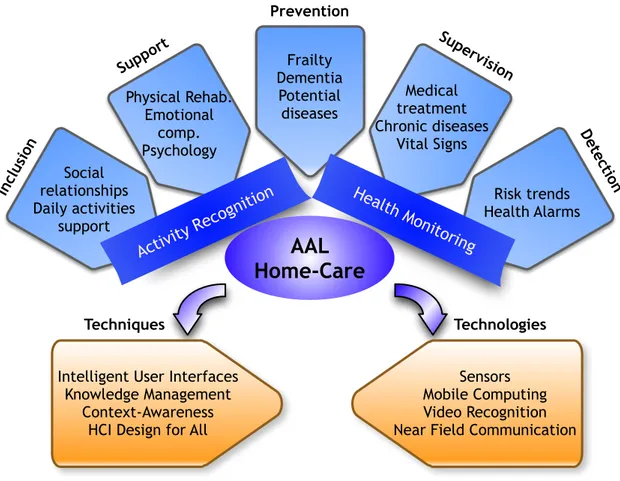UNIVERSIDADE DA BEIRA INTERIOR Faculdade de Engenharia
Departamento de Informática
Web Services Approach for
Ambient Assisted Living in
Mobile Environments
Joel Lourenço Fernandes
Submitted to the University of Beira Interior in candidature for the Degree of Master of Science in Informatics Engineering
Supervised by Prof. Dr. Joel José Puga Coelho Rodrigues
Departamento de Informática University of Beira Interior
Covilhã, Portugal http://www.di.ubi.pt
i
This work has been partially supported by the Instituto de Telecomunicações, Next Generation Networks and Applications Group (NetGNA), Portugal, by National Funding from the FCT – Fundação para a Ciência e Tecnologia through the Pest-OE/EEI/LA0008/2011, and by the AAL4ALL (Ambient Assisted Living for All), project co-financed by the European Community Fund FEDER through COMPETE – Programa Operacional Factores de Competitividade.
iii
Acknowledgements
First of all, I would like to thank Prof. Joel José Puga Coelho Rodrigues for giving me a chance to join the Next Generation Networks and Applications Research Group (NetGNA), for all the constant words of encouragement and for supervising my Master’s Thesis. The last year was undoubtedly very important in my evolution has Informatics Engineer as a person as well.
I am most grateful to the University of Beira Interior, the Instituto de Telecomunicações, Next Generation Networks and Applications Group (NetGNA), Covilhã Delegation, Portugal, by National Funding from the FCT – Fundação para a Ciência e a Tecnologia through the PEst-OE/EEI/LA0008/2011 Project, by the AAL4ALL (Ambient Assisted Living for All), project co-financed by the European Community Fund FEDER through COMPETE – Programa Operacional Factores de Competitividade.
Many thanks to all members of NetGNA, particularly Ivo Lopes, Fábio Canelo, Edgar Horta and João Dias.
And of course, a enormous thanks to my parents, my sister, my family and my girlfriend, for their constant support and for all words of motivation.
v
Abstract
Web services appeared as a promising technology for Web environments independent of technologies, services, and applications. First, a performance comparison study between the two most used Web service architectures, SOAP and REST, is presented, considering messages exchange between clients and a server. Based on this study, the REST architecture was chosen to deploy the system because it gets better results compared to SOAP architecture. Currently, there are some issues related with this approach that should be studied. For instance, if massive quantities of data are sent to databases it can influence significantly the performance of the whole system. The Advanced Message Queuing Protocol (AMPQ) appears as a promising solution to address this problem. Then, in order to evaluate the performance of this approach, this work presents a performance evaluation and a comparison study of RESTful Web services and the AMQP Protocol considering exchanging messages between clients and a server. The study is based on the averaged exchanged messages for a certain period of time. It was observed and concluded that, for large quantities of messages exchange, the best results comes from the Advanced Message Queuing Protocol. Message Queuing Telemetry Transport (MQTT) was addressed in this work because it is a similar protocol to AMQP but it can be used by mobile devices with a processing capacity smallest unlike the AMQP that needs greater processing capacity. These studies are performed in the context of Ambient Assisted Living environments, since
vi
the work was applied to this topic in order to experiment the effectiveness and evaluate the performance of these protocols in this scenario.
vii
Keywords
Web Services, RESTful, Advanced Message Queuing Protocol, AMQP, Message Queuing Telemetry Transport, MQTT, RabbitMQ, Ambient Assisted Living, AAL.
ix
Contents
Acknowledgements ... iii
Abstract ... v
Keywords ... vii
Contents ... ix
List of Figures ... xi
List of Tables ... xiii
Acronyms ... xv
1.
Introduction ... 1
1.1. Focus and Research Scope ... 1
1.2. Problem Definition ... 9 1.3. Research Objectives ... 10 1.4. Main Contributions ... 10 1.5. Dissertation Structure ... 11
2.
Related Work ... 13
2.1. Web Services ... 132.1.1. Web Services Platform Elements ... 18
x
2.3. Message Queuing Telemetry Transport (MQTT) ... 27
2.4. Ambient Assisted Living (AAL) ... 30
3.
Requirements Analysis ... 35
3.1. Essential Requirements ... 35 3.1.1. Entity-Relationship Model ... 36 3.1.2. Activity Diagrams ... 37 3.1.3. Sequence Diagrams ... 40 3.2. System Architecture ... 42 3.3. Used Technologies ... 434.
Performance Evaluation ... 45
4.1. REST versus SOAP ... 45
4.1.1. Markup Languages ... 50
4.2. Advanced Message Queuing Protocol (AMQP) versus Message Queuing Telemetry Transport (MQTT) ... 53
4.3 Systems Demonstration and Validation ... 57
4.3.1 RESTful Web Service, RabbitMQ server and Back-end Service 58 4.4 Results Analysis ... 61
5.
Conclusions and Future Work ... 67
5.1 Conclusions ... 67
5.2 Future Works ... 69
References ... 71
xi
List of Figures
Figure 1. Illustration of Two-tier architecture. ... 1
Figure 2. Illustration of a three-tier architecture. ... 2
Figure 3. Basic process of functioning of systems implemented for the AAL... ... 7
Figure 4. Service Oriented Architecture (SOA) diagram. ... 20
Figure 5. WCF endpoint – ABC (Address, Binding and Contract). ... 21
Figure 6. Illustration of RESTful Web Services architecture. ... 22
Figure 7. Illustration of the process of exchanging messages using RabbitMQ... ... 27
Figure 8. Example of MQTT network topology. ... 29
Figure 9. Topics, techniques and technologies applied in Ambient Assisted Living. ... 32
Figure 10. Entity-Relationship Diagram based in IDEF1X notation. ... 36
Figure 11. Request / send path to the Web services activity diagram. ... 38
Figure 12. Request and sender path to the RabbitMQ activity diagram. . 39
Figure 13. Sequence Diagram – Communication between Client (Mobile Application) and Web service to insert or get data in / from database. ... 40
Figure 14. Sequence Diagram – Communication between Client (Mobile Application) and RabbitMQ Server. ... 41
Figure 15. Sequence Diagram – Communication between Back-end service and RabbitMQ server and database. ... 41
Figure 16. Illustration of the global system architecture. ... 42
xii
Figure 18. Performance comparison considering the number of message for tree different experimental scenarios showing the messages stored in the Database, RabbitMQ,and the average messages per second. ... 63
xiii
List of Tables
Table 1. HTTP Methods and their corresponding CRUD Action ... 23 Table 2. Products that support AMQP ... 24 Table 3. Strengths and Weaknesses for both SOAP and REST. ... 46 Table 4. Results of the Performed Experiment to Compare SOAP with REST Web Services. ... 48 Table 5. Methods implemented in the Web service reference to the HTTP method to use ... 59 Table 6. Results of the Performed Experiments. ... 62
xv
Acronyms
AAL : Ambient Assisted Living ACL : Access Control List
AMQP : Advanced Message Queuing Protocol API : Application Programming Interface CORBA : Common Request Broker Architecture CPU : Central Processing Unit
DCOM : Distributed Component Object Model DLL : Dynamic-Link Library
ECG : Electrocardiogram
HER : Electronic Health Record HTML : Hypertext Markup Language HTTP : Hypertext Transfer Protocol
ICT : Information and Communication Technology ISO : International Organization Standardization JSON : JavaScript Object Notation
LDAP : Lightweight Directory Access Protocol MQTT : Message Queue Telemetry Transport QoS : Quality of service
REST : Representational State Transfer RFC : Request for Comments
RMI : Remote Method Invocation ROA : Resource-Oriented Architecture RPC : Remote Procedure Call
SASL : Simple Authentication and Security Layer SMTP : Simple Mail Transfer Protocol
xvi
SOA : Service-Oriented Architecture SOAP : Simple Object Access Protocol
TCP/IP : Transmission Control Protocol / Internet Protocol TLS : Transport Layer Security
UDDI : Universal Description Discovery and Integration UML : Unified Modeling Language
URC : Universal Remote Console URI : Uniform Resource Identifier W3C : World Wide Web Consortium
WADL : Web Application Description Language WCF : Windows Communication Foundation WSDL : Web Service Definition Language XML : eXtensible Markup Language YAML : YAML Ain’t Markup Language
Introduction
1
1. Introduction
1.1. Focus and Research Scope
The idea of distributed computing was born with the appearance of computer networks. Applications were divided first into two main components. One is the client, starting a distributed activity, and the other, the server, carrying out that activity. This reorganisation minimized bottlenecks by distributing the workload through several systems. It offered flexibility for application design previously nearby unknown on centralized hosts. But this two-tier architecture, Figure 1, had its limits [1].
Client PC Java Application Client Server Tier 1 Tier 2 JDBC Driver Storage Server
Figure 1. Illustration of Two-tier architecture.
For scalability and failover, issues a third-tier has been announced, dividing an application into a presentation part, an intermediate tier including the business logic, and a third-tier dealing with the data. This three-tier model of distribution, presented in Figure 2, has become the
Introduction
2
most popular way of splitting applications. It makes application systems scalable.
The basis for the communication between the distributed parts of an application is the remote procedure call (RPC) [1].
Client PC
Browser
Tier 1
Tier 2
Tier 3
Client
Application
Services
DBMS System
RPC / HTML SQL Data Access
Figure 2. Illustration of a three-tier architecture.
The main use of the World Wide Web is interactive access to documents and applications. In nearly every case, access is by human users, generally working through Web browsers, audio players, or other systems of interactive front-end. The Web can grow greatly in power and scope if it is extended to support communication among applications, from one program to another.
The Web has been a phenomenal success at allows simple computer/human interactions at Internet scale. The original HTML and HTTP protocol stack used by current Web browsers has proven to be a cost- effective way to project user interfaces onto a wide range of devices. The main factor in the success of HTML and HTTP was their relative simplicity — both HTML and HTTP are primarily text-based and can be implemented using a multiplicity of operating systems and programming environments.
In the last few years, ad hoc styles have been used in business-to-business applications to enjoy the benefits of the basic Internet infrastructure [2]. The wondrous growth of the information space and the wondrous number of accessible information sources are factors which arise a growing interest for integrating information sources into Web services in
Introduction
3 order to improve collaboration and knowledge sharing between enterprises. The appearance of Web services as a model for incorporating heterogeneous Web information has opened new possibilities of interaction and provided more potential for interoperability.
Currently, more and more Web services are present in applications, serving information or consuming a service. Within the context of distributed applications, the service has become a important, switching the old paradigm of using Dynamic-Link Library (DLL) [3].
The growing number of available Web services, the increase necessity to collaborate and to share knowledge directing to the best decisions are factors which generate a growing interest for meeting Web services into communities in order to facilitate and accelerate Web services discovery and selection. Web services communities provide a centralized access to several functionally-equivalent Web services through a unique endpoint which enables the query processing [4].
For end users, the large growth in available services can involve greater freedom or more chaos or both. For developers, Web services computing provide important theoretical and engineering challenges as they determine how to take advantage of emerging technologies to automate individual applications. The era of globalization as purchased nearly all services to the Internet environment with multiple providers offering the same service in different ways [5]. Several providers are provide the same functionality so it necessary to distinguish one self from the crowd with the aim to prosper against the cutthroat competition from the service provider’s view. On the other hand it is absolutely necessary for the client to choose a service provider that not only meet the functional requirements of the client but also offers the best quality of service (QoS) to the customers.
Mobile Internet is driving the exponential growth of mobile devices in a faster way than previous computing technologies. Mobile Internet devices has surpassed ten billion units in 2010 [6]. With the increasing use
Introduction
4
of mobile devices, mobile applications will create a larger percentage of Web service requests.
Mobile platforms have their own set of challenges as: bandwidth, memory and CPU availability, storage capacity, connectivity options and issues, security and user interaction and display. Since the capacity of storage and processing on mobile devices is reduced to best solution for mobile applications that generate large amounts of data or need to save too many messages, passes to use other services to send and store messages outside the device. Against this problem, increasingly, the option is to use Web services to send data from the mobile device to a server.
The Web services are the key point of integration for different applications pertaining to different platforms/languages/systems once they are based in a set of standards that make them independent of the underlying technologies used for providing them. There are currently two groups of thinking in the development of Web services: the traditional, standards-based approach (SOAP) and conceptually simpler and the trendier on the block (REST). Spite of the fact that the requirement of mobile computing has improved considerably in recent years [7], [8], using traditional Web services (i.e., SOAP-based services) models to mobile computing may result in unacceptable performance overheads.
Simple Object Access Protocol is extensively used as a messaging framework for Web services realization of Service Oriented Architecture (SOA). This standard is not suitable for mobile devices with resource constraints, provisioning Mobile Web Services, due to large payloads of SOAP message constructs. In addition to memory limitations, the data parsing of the intensive SOAP messages can lead to performance degradation of the mobile Web servers in terms of server utilization. In contrast, the Representational State Transfer (REST) messaging framework is lightweight enough to be appropriate for messaging communication in such devices. A single URL only identifies each service resource in this framework [9].
Introduction
5 REST is an architectural style derived from the Web, and its constraints and architectural elements aim at gathering the fundamental design principles that enable the great scalability, growth, and success of the Web. A RESTful service is provided as a resource, which is meaningful concept and can be addressed in the Web. A RESTful service is supplied as a feature, which is the concept extremely useful and can be addressed on the Web. As the Internet grows continuously, new needs are identified, and to confront them, new approaches are emerging. One is the pub-sub (publish-subscribe), wherever the messaging middleware is an operating model with asynchronous and freely combined characteristics. As the message consumers and producers in control flow, space and time are totally dissociated, doing the two endpoints communicate using a distinct statement and registration messages for asynchronous communication, which can better serve dynamic distributed information systems integrations needs and the large-scale. The existing applications of subject based pub-sub were used effectively in the mobile computing, stock, financial and other situations [10].
SOAP-based services are heavy-weighted services, which are not applicable for mobile services in comparison to light weighted RESTful services. Migration of SOAP-based services to RESTful services makes the services more pervasive, faster, and suitable for thin clients. In addition, RESTful services are invoked using HTTP methods [3].
Whatever the technology used to deploy Web services, they provide several advantages [11], like language independence and distribution mechanisms; it also increases the interoperability between different soft- ware elements (for example, it is possible to add communication libraries without modifying existent code), and facilitates code distribution (it is not required the use of a concrete implementation or library) among geographically distributed work teams.
The healthcare industry offers many more situations in which Web services can be put to use effectively. A doctor carrying a handheld device can access your records, health history, and your preferred pharmacy using
Introduction
6
a Web service. The doctor can also write you an electronic prescription and send it directly to your preferred pharmacy via another Web service.
The high penetration of mobile devices and networks implies that mobile technology cloud be used very effectively for health promotion in order to compensate the lack of resources problem, particularly in developing countries.
Over the past decade, new application areas in healthcare, such as Ambient Assisted Living (AAL) has improved the interest of community safety engineering. They are reliant upon information gathered from their environment through small, hidden, distributed, and communicating embedded devices for offer their services and are open to the integration of new and heterogeneous devices to optimize offered services. Under these circumstances they must be able to react appropriately to the variation observed in their environment, in the quality of information provided by the embedded devices and in the availability of resources.
The Information and Communication Technologies (ICT) can play a very important role to achieving these goals. ICT can contribute an to a better quality of life for older people contributing to a more healthy and independent life, opposing the difficulties of this age group. This therefore the starting point for the concept of AAL.
From the point of view of AAL, people with special needs are supported through an interaction with the intelligent environment that surrounds them, facilitated by devices capable of measuring several parameters, acting on the environment, with a capacity of computing and communications. So, the passage of the personal computer/device for a range of devices capable of sensing processing and distributed computing environment and by a new paradigm that yields a set of challenges related to the interaction of people with technology in their environment.
The concept AAL refers thus to the study and development of intelligent systems to support the requirements of quality of life, offering a secure conditions in daily environment preferred by user. In AAL are
Introduction
7 proposing new approaches in design of products and services that interlink and enhance new technologies in a social environment.
Figure 3 shows the basic process of functioning of systems implemented for the AAL. The sensors / robot send data to the Home Node (gateway). Subsequently the gateway sends this data to a server. Consumers intending to have access to data make requests to the server and it returns the required information.
HOME NODE (gateway) Sensors Internet Internet Consumer Server Robot
Figure 3. Basic process of functioning of systems implemented for the AAL.
Ambient Assisted Living (AAL) research the development of systems that monitor activities and vital signs of lonely elderly people in order to detect emergency situations or deviations from desirable medical patterns [12]. The discussion about Ambient Assisted Living started when political entities couldn’t ignore the fact of the demographic change any longer [13].
Introduction
8
The large potential of these AAL technologies related to the capacity to influence people to live in a positive way. In particular, the AAL has influences on the following:
• Support the maintenance of health and functional capacity of older people;
• Improved safety in the physical integrity of the end users, especially those who have illness and/or physical limitations; • Promoting a healthier lifestyle for people at risk;
• Extension of time that user can live in there preferred environment with safety and proper socialization;
• Contribution to the extension of working lives of people, in that they provide a set of tools and in his own house, ensuring comfort conditions and adequate security and maintaining contact with the entities with whom they interact;
• Increased efficiency and productivity of the resources used in aging societies.
All of these features enable a greater capacity for participation of individuals in society regardless of age, sex, education level or economic origin. The enhancements in the health of users and development of numerous technologies such as, for example, telemedicine from home or use of wearable sensors also contribute to reduce the resources used and therefore the associated costs.
Moreover, the points identified as the weak current AAL solutions in general:
• Solutions are typically high cost;
• These solutions, in many cases, highly technological and complex use which can hinder their use by the target users;
• Solutions based on body monitoring devices, it’s hard to get the trio, comfort, volume and autonomy;
Introduction
9 • The difficulty in achieving an objective study on the real needs
of end users, leads to the development of solutions that often are not adapted or are not of practical use for these;
For making monitoring activity and vital signs are used devices, such as mobile devices, sensors, etc., with little processing power, low memory and limited battery. Given these problems it is necessary to implement solutions of low energy consumption, with data packets minimized and they can make the efficient distribution of information to one or many receptors. Advanced Message Queuing Protocol (AMQP) e Message Queuing Telemetry Transport (MQTT) are both open protocols for asynchronous message queuing which have been developed and matured over several years. AMQP has selected the OASIS industry standards group, whit the intention of moving to becoming an ISO/IEC standard [14]. MQTT has chosen to use the Eclipse foundation [15].
1.2. Problem Definition
Ambient Assisted Living focuses on the development and market of products and services that can be used for user monitoring and events detection. Thus, it is possible that users live in more secure conditions and in their preferred environment. Constant monitoring by sensors or other devices generates large amounts of data to be transmitted and stored.
A problem that arises in this area is the large amount of data that is generated and needs to be transmitted. In this way it is necessary to study and develop mechanisms and apply systems that allow the exchange of large amount of data to be made as quickly as possible and with no loss of data.
In the present study is carried out the comparison between the two models for transmitting large amounts of data with the aim of find the best solution to solve that problem.
Introduction
10
1.3. Research Objectives
The main objective of this dissertation is the design, constructing, deployment, and performance evaluation of Web services when employed in system that generate large amounts of data. To carry out this study, Web services have been applied in mobility systems for the Ambient Assisted Living.
To reach this main objective the following intermediate objectives were define:
• Study of the state of the art, about Web services, Advanced Message Queuing Protocol, Message Queuing Telemetry Transport and Ambient Assisted Living (AAL);
• Detailed analysis of the RESTful Web services and RabbitMQ; • Requirement analysis of Web services and message queuing
protocols considering ambient assisted living (AAL) environments with mobility support;
• Proposal, deployment, and validation of the system based on requirements analysis;
• Performance evaluation of Web services and RabbitMQ considering an AAL system with mobility support.
1.4. Main Contributions
This section is devoted to the scientific contributions of this dissertation to the stat-of-the-art on Web services and Advanced Message Queuing Protocol (AMQP). The main contribution is the Performance Evaluation of RESTful Web Services and AMQP Protocol that presents a performance comparison study of RESTful Web services and the AMQP Protocol considering exchanging messages between client and server. The study is based on the averaged exchanged messages for a period of time.
Introduction
11 This study was presented at The Fifth International Conference on Ubiquitous and Future Networks (ICUFN 2013), Da Nang, Vietnam, July 2-5, 2013.
1.5. Dissertation Structure
This dissertation is organized in five chapters. This Chapter, the first, presents the context of the dissertation, focusing on the topic under study, the problem definitions, the objectives, the main contributions and the dissertation structure.
Chapter 2 - Related Work – Presents the literature review on Web
services, Advanced Message Queuing Protocol, Message Queuing Telemetry Protocol and Ambient Assisted Living. Referring some of the work done in each of the topics mentioned above.
Chapter 3 – Requirements Analysis – This chapter presents the
design and implementation of the system architecture developed. Presents the system architecture, the conceptual design of the system proposed and the technologies used in the development of proposed application.
Chapter 4 – Performance Evaluation – This chapter presents the
comparison between the implemented services and equivalents, and between communication protocols implemented. It also focuses on the demonstration of the system and evaluates the performance of two approaches developed that will be integrated into applications AAL.
Chapter 5 – Conclusions and Future Work – Concludes the
Related Work
13
2. Related Work
In order to fully understand the context of the thesis objectives and have an awareness of the state-of-the-art, it is required to approach the related work, as a study of the literature review.
This chapter presents the literature review. In section 2.1 is presented the literature review in Web services with reference to multiple Web service technologies, making a comparison between the two most widely used. Section 2.2 present the literature review in Advanced Message Queuing Protocol focusing interest in the RabbitMQ, used in the development of this thesis. In section 2.3 is presented the literature review in Message Queuing Telemetry Transport protocol can also be used with RabbitMQ. Finally, section 2.4 presents the literature review in Ambient Assisted Living, area chosen to implement Web services and RabbitMQ to evaluate their performance.
2.1. Web Services
The predecessors, such as the Common Request Broker Architecture (CORBA), Remote Method Invocation (RMI) and Distributed Component Object Model (DCOM), Web Services is a set of standards and programming methods for the exchange of data between different software applications, Web services also is a standardized way for distributing services on the Internet [14].
In the last years, Web Services technologies have been used successfully to simplify interoperability, while providing scalability and flexibility in various applications, including distributed simulation software.
Related Work
14
The W3C [16] defines a Web service as a method of communication between two electronic devices over a network, it is a solution used in systems integration and communication between different applications. With this technology it is possible that new applications are able to interact with those that already exist and that systems developed across different platforms are compatible. Primarily, the Web service makes the resources of the software application available on the network in a standardized way. In current collaborative environments, Web Services seems to be a privileged means to interconnect applications across organizations, even if those organizations use different operating systems, different hardware, and different programming languages. Web Services are software systems projected to support interoperable machine-to-machine interaction over a network [17] by using URI (Uniform Resource Identifier) on the distributed environment of internet. They are modular applications with interface descriptions that can be published, located, and invoked across the Web [18].
Web Services they became gradually popular method of managing inter-system communications through networks, with the ubiquity of HTTP, XML, and JSON in modern computing. A Web services-based architecture results in complex system that demands coordination, communications, and distributions among loosely coupled system with dependent users in order to provide scalability, flexibility and extensibility. In its simplest form, Web services refer to software components that support interoperability between computer systems connected over communications network. The key elements of Web Services include, HTML, XML, JSON, SOAP, UDDI, WSDL.
The potential widespread use and benefits of Web Services are very compelling, because they facilitate:
• Automation of business processes distributed across multiple enterprises;
• Collaboration among multiple enterprises by coupling together the business processes running on their various computers.
Related Work
15 The Web Service technology has become an industry standard for connecting remote and heterogeneous resources, mobile devices have become a vital part of people’s everyday life. People use mobile devices anytime and anywhere, they may use their mobiles to check Email, access the Internet, or run other Web applications.
A Web service is a piece of business logic, located somewhere on the Internet, that is accessible through standard-based Internet protocols such as HTTP or SMTP [19]. Using a Web service could be as simple as logging into a site or as complex as facilitating a multi-organization business negotiation.
There is a multitude of Web services and applications programming interface (APIs) available on the Web offer a wider variety of various services and generally, has considerable semantic overlap between them, where several Web services deliver basically the selfsame functions. This superimposed feature allows redundancy in the ecosystem of Web services and offers developers the chance to transfer from one API to another while the API initially used is not available or inadequate for their requirements. To help the innovation of similar APIs, many novel methods are being developed to finding the Web services, including query-based methods relying on keywords and identifiers [20], [21], clustering [22] and more detailed structure matching [23], [24].
REST (Representational State Transfer), the architectural style underlying the Web [25], has gained acceptance as an alternative way to develop Web services [26]. This trend is witnessed by several deployed RESTful Web services in the industry, such as Amazon S3 and Facebook API, as well as active researches and studies on REST Web services [27], [28], [29].
RESTful Web Services are earning more and more approaches. They are used as application programming interfaces (APIs) for Web Services 2.9, and are considered a more flexible and lighter-weight alternative to the so-called Big Web Services [30].
Related Work
16
RESTful Web Services technical topics become popular because the REST style includes a global identifier of all resources (eg, a uniform resource identifier) and the customer only need to know this handle and the action required. He must also know the right format of representation, which is typically an HTML, eXtensible Markup Language (XML) or JavaScript Object Notation (JSON) meta-data. RESTful Web services (REST APIs) specify a set of resources, which includes three components: the URI of the Web service, the data type supported (JSON, XML, etc.), and the support operations through HTTP methods.
Much research has been done in the field of developing RESTful applications. Richardson and Ruby [26] provide best practice examples and hints on how to develop RESTful applications.
Kopecky et al. [31] present hRESTS as a solution for missing machine-readable Web APIs of RESTful services. They argue that a micro format is the easiest way to enrich existing human-readable HTML documentations. They introduce a model for RESTful services, but with a focus on documentation and discovery.
Alarcón and Wilde [32] introduce a metamodel for descriptions of RESTful services which is the basis for the Resource Linking Language. They focus on service documentation and composition.
Furthermore, Liu et al. [33] introduce an approach for reengineering legacy systems to RESTful Web Services. They outline the key issues in this area and propose a solution that covers identification of resource candidates, relation and operation analysis, URI and representation design, as well as service construction. In their opinion, the key problem is to find the right granularity for the resources.
In the domain of model driven development, Laitkorpi et al. [28] propose a process for designing RESTful services that focuses on a model based identification of the resources and on generating corresponding WADL descriptions.
Mayer and Lubke [34] also highlight the need to bring formal testing and validation into the area of Web applications, pointing out that many of
Related Work
17 the existing tools for BPEL Testing concentrate only on black box testing, to the exclusion of any kind of white box testing.
In [35], they discussed a number of areas in which Web services create additional testing problems. They conclude that Web services need to confront additional problems of scale, such as work flow complexity, volume of data, number of nodes, complexity of operations and differences in usage patterns.
C. Riva et al. [36] investigate how to apply the REST principles to the design of mobile services. They identified several issues such as latency and data format that need particular attention when applying REST concepts to mobile environment. However, they only focused on consuming RESTful Web Services on mobile devices and did not address the provision of Web Services from a mobile host.
Web Services technology recognizes mobile computing as an area to which it should expand. Through integration, Web Services enable pervasive accessibility by allowing for user mobility as it overcomes the physical location constraints of conventional computing. However, mobile computing also requires a technology that connects mobile systems to a conventional distributed computing environment. Web services may be the perfect candidate for such connections, since a strong interoperable capability is the key requirement of the technology. The integrations of mobile computing with Web Services technology will give many advantages to both sides.
Mobile computing and Web Services are becoming popular in collaboration systems, with mobile computing adding heterogeneity to collaboration systems and Web Services providing interoperability. Mobile computing has largely improved in recent years, applying traditional Web Services (i.e. SOAP-based services) models to mobile computing may result in unacceptable performance overheads.
Related Work
18
2.1.1. Web Services Platform Elements
Web services are a set of tools that can be used in a number of ways. The three most common styles of use are the Remote Procedure Calls (RPC), Service-Oriented Architecture (SOA) and Representational State Transfer (REST).
RPC – Remote Procedure Calls
RPC Web services present a distributed function (or method) call interface that is familiar to many developers. Typically, the basic unit of RPC Web Services is the WSDL operation.
• WSDL
The WSDL (Web Services Description Language) [37] Is a specification developed by W3C that describes the Web Service according to an XML format, working as a contract of service. The WSDL is extensible to allow description of services and their messages regardless of message formats and network protocols that are used. However, it is common to use the MIME (Multipurpose Internet Mail Extensions) and SOAP.
The WSDL describes the service available on the network through a semantic XML, this provides the necessary documentation to be called a distributed system and the procedure required for this communication is established. While SOAP specifies the communication between a client and a server, the WSDL describes the services offers.
A WSDL description contains all the details of a Web Service, including the service’s URL, the communication mechanisms it understands, what operation it can perform and the structure of its messages.
• SOAP
Simple Object Access Protocol is a protocol for exchanging structured information in a decentralized and distributed platform. It is
Related Work
19 based on Extensible Markup Language (XML) to format the messages, and usually based on other application layer protocols, most notably in Remote Procedure Call (RPC) and HTTP for trading and messaging, using GET/POST over HTTP, allowing the data to be exchanged independent where the user is in the network.
SOA – Service-Oriented Architecture
Web Services can also be used to implement architecture according to service-oriented architecture (SOA) concepts, where the basic unit of communication is a message, rather than an operation. This is often referred to as “message-oriented” services.
In the traditional client server world, we had the server offering some functionality that could be used or called by the client. Some kind of look up service acted as a broker between the client and the server.
Since Web Service represent just another paradigm for distributed applications, they consist of the same three components [1]:
• A service broker that acts as a look up service between a service provider and a service requestor. This is a logically centralized directory of services.
• A service provider that publishes its services to service broker. The service provider implements the service and makes it available on the Internet.
• A service requester that asks the service broker where to find a suitable service provider and that binds itself to the provider. This is any consumer of the Web Service. The requester utilizes an existing Web Service by opening a network connection and sending any request.
Each Web Service has an API that can be accessed over the network and executes the Web service at host location. Every service provides a role, such as service provider, a requester or a broker. In other words, Web
Related Work
20
Services make possible the effective processing or machine readable information.
The Figure 4 illustrates the relationships between the Web Services components. Service Requester Service Broker Service Provier Find Publish Internet Bind Service Description Web Service
Figure 4. Service Oriented Architecture (SOA) diagram.
• WCF
Windows Communication Foundation (WFC) [38] is the Microsoft platform available since –NET Framework 3.0, used to handle the communication between systems. WCF is a union of a Web Service, and Remoting, all in a single platform, simple to use, robust and easy integration.
WCF is designed in accordance with service oriented architecture principles to support distributed computing where consumers consume services. A WCF client connects to a WCF service via an EndPoint. Each service exposes its contract via one or more endpoints. An endpoint has an address with a URL specifying where the endpoint can be accessed, and binding properties that specify how data will be transferred. An endpoint (Figure 5) contains three main features called ABC (Address, Binding and
Related Work
21 Contract). An analogy for these features is that the Address is where the service is hosted, Binding is how the service can be accessed, and the Contract would be seen in service.
EndPoint
Address
(Where)Binding
(How)Contract
(What)Figure 5. WCF endpoint – ABC (Address, Binding and Contract).
REST – Representational State Transfer
Roy Fielding introduced the term REST in his PhD dissertation [25], where he referred to “hypermedia as the engine of application state”. This means that a resource is expected to contain hyperlinks. These hyperlinks are the method by which a transition can take place that changes the resource state or transfers to another resource. While hyperlinks are commonplace in (X)HTML applications meant to be used by humans, they have not typically been used in XML, which is meant to be consumed by machines. Like (X)HTML, REST Web Services make use of hyperlinks in XML.
To understand REST, it is necessary to understand the definition of resource, representation and state. A resource can be anything, may be a physical object or an abstract concept. Usually a resource is something that can be stored on a computer and represented as a stream of bits. A representation is any useful information about the state of a resource. A resource may have multiple different representations. In REST there are
Related Work
22
two types of state. One is resource state, which is information about a resource, and the other is application state, which is information about the path the client has taken through the application. Resource state stays on the server and application state only lives on the client. Rest provides a set of architectural constraints that, when applied as a whole, emphasizes scalability of component interactions, generality of interfaces, independent deployment of components, and intermediary components to reduce interaction latency, enforce security, and encapsulate legacy systems.[25]
In REST, the server is abstracted into a set of resources. A resource is a nominal concept, so the modeling based on REST is noun-centralized, which is a domain model [39]. Figure 6 shows the architecture of RESTful Web Services. Client communicates with server via a uniform interface and during the stateless communication; client and server swap features depictions. Therefore, the REST design restrictions supply a standardized method to develop an API wearing the HTTP protocol.
Client Server
HTTP Verb:
GET | POST | PUT | DELETE
HTTP Packet
Resource Representation
HTTP HTTP
Stateless Web Service Conversation
Figure 6. Illustration of RESTful Web Services architecture.
Old-style Web applications access methods using HTTP operations (GET and/or POST). Contrasting with this, applications RESTful access methods according to the following functions: create, read, update, and delete (CRUD) style using the full range of HTTP methods (GET, POST, PUT
Related Work
23 and DELETE). Table 1 shows a mapping of HTTP methods to these CRUD actions.
Thus, the RESTful design constraints provide a standardized way to build an API using the HTTP protocol. This design includes correct use of standard HTTP methods and return codes.
Table 1. HTTP Methods and their corresponding CRUD Action
HTTP Method CRUD Action
GET Retrieve a resource
POST Create a resource
PUT Update a resource
DELETE Delete a resource
RESTful Web Services can be depicted over the Web Applications Description Language (WADL). A WADL file sets out the requirements that can be legally directed to a service involving the service uniform resource identifier (URI) and service data waiting and serves.
REST architecture is an architecture style for designing networked applications [40]. Grounded in distributed hypermedia systems and software engineering.
REST and Resource-Oriented Architecture (ROA) support a wide range of representation formats, including plain text, HTML, XML, and JavaScript Object Notation (JSON).
2.2. Advanced Message Queuing Protocol (AMQP)
The Advanced Message Queuing Protocol (AMQP) is a open standard middleware message. Accordance with the AMQP standard, middleware products developing for various platforms and in various languages can submit messages from one to another. AMQP is borne by a number of
Related Work
24
important companies, including JPMorgan Chase Bank, Cisco Systems, Credit Suisse, Deutsche Börse Systems and Red Hat [41].
Advanced Message Queue Protocol (AMQP) originated in the financial services industry in 2006 [41] [42] [43]. AMQP is an open standard for Message Oriented Middleware (MOM) communication. AMQP grew out of the need for MOM system integration both within and across corporate enterprise boundaries.
Although AMQP specification is not finalized yet, several products supporting different drafts of AMQP exist today (Table 2), as the Red Hat, VMware, Ltd and OW2 Consortium who use the 0-9-1 version of AMQP, the Apache Software Foundation and the Stormmq who use the 0-10 version. It is used to simplify critical tasks, for example, JPMorgan reported a AMQP environment support 2,000 users on five continents to process 300 million messages per day. Every products that are listed comes with client library for different programming language, such, C++, Ruby, Java, and Python [44].
Table 2. Products that support AMQP
Developer Product AMQP version
VMware, Ltd RabbitMQ 0-9-1
Red Hat Red Hat Enterprise MRG n/a
OW2 Consortium JORAM 0-9-1
Apache Software Foundaton Apache Qpid™ 0-10
Stormmq stormmq 0-10
The primary reasons for choose the AMQP as proprietary alternatives are the following realize the savings commoditization brings, connect applications on different platforms, connect to business partners using a full featured open standard and position for innovations built upon the foundations of AMQP.
AMQP enables applications to send and receive messages. In this regard it works like instant messaging or eMail. AMQP differs enormously from other available solutions comes from the fact that it allows the
Related Work
25 specification of what messages can be received and from, and how trade-offs are performed with respect to security, reliability, and performance. Systems built to integrate AMQP perform much better at functioning unattended or “lights-out” than other solutions.
Systems built to integrate with AMQP are much better at functioning unattended, or “lights-out”, than other solutions.
AMQP is different from other middleware standards because it is: • Interoperable – All AMQP clients interoperate with all AMQP
servers. Diverse programming languages can communicate easily. Legacy message brokers can be retrofitted to remove proprietary protocols from your network. Messaging can be enabled as a cloud service.
• Reliable – Capable of eliminating the communication gaps and slowdowns between different platforms, critical systems and applications components both within enterprise and out to external systems and organizations.
• Unified – Provide a core set of messaging patterns via a single manageable protocol.
• Complete – AMQP provides a wire level transport for applications using that API. AMQP is broadly applicable and can be leveraged by any language, and identifies both store-and-forward and publish-and-subscribe semantics in on specification.
• Open – Vender and platform agnostic, and created by users and technology provides working in collaboration.
• Safe – A secure solution to the problem of transporting value-bearing messages across and between organizations, technology platforms and a virtual cloud computing environment.
I will show the performance of RabbitMQ that implements the Advanced Message Queuing Protocol standard. RabbitMQ is an open source message broker and queuing server that can be used to let disparate
Related Work
26
applications share data via a common protocol, or to simply queue jobs for processing by distributed workers.
RabbitMQ server is written in Erlang and is built on the Open Telecom Platform framework for clustering and failover. The RabbitMQ project consists of:
• The RabbitMQ exchange server itself;
• Gateways for HTTP, STOMP, and MQTT protocols;
• AMQP client libraries for Java, .NET Framework, and Erlang; • A plug-in platform for custom additions, with a pre-defined
collection of supported plug-ins.
The main characteristics of RabbitMQ project include the following: the RabbitMQ interchange server; gateways for protocols (HTTP, STOMP, and MQTT); AMQP client libraries for .NET Framework, Java, and Erlang; and a plug-in platform for personalized add-ons, with a pre-stated collection of sustained plugins.
AMQP defines an efficient and flexible publish/subscribe interface that is independent of the data model. AMQP uses a central server, or broker, but the RabbitMQ implementation can be scaled linearly by distributing the broker over multiple physical nodes [45].
With the creation of a group of publishers and subscribers can access the nodes of messages, is possible to create an information network that can span from small to very large scale in a local area, or over the large geographical distance. The distribution of information sent from the publishers to the hub to be distributed to the necessary subscribers allows for applications to run while relying on data from other locations, wherever they may be. This allows RabbitMQ to be useful in designing architectures for small-localized systems to large, geographically dispersed interactive systems.
Figure 7 presents the basic process of exchanging messages using RabbitMQ.
Related Work 27
Consumer
Producer
Messages
Exchanges
Bindings
Queues
Topic
Fanout
Direct
Message Message Message Message Message
Q1
Q2
Q3
Q4
Q5
ap i_ca ll *.se ve re log s. *Figure 7. Illustration of the process of exchanging messages using RabbitMQ.
2.3. Message Queuing Telemetry Transport (MQTT)
Message Queue Telemetry Transport (MQTT) is a publish/subscribe messaging protocol created in 1999. The idea of MQTT is to is to be extremely simple and lightweight. It is designed for constrained devices and low-bandwidth, high-latency or unreliable networks. The aim of MQTT is to minimize network bandwidth and device resource requirements while also attempting to ensure some level of reliability. MQTT is intended for "machine-to- machine" (M2M) or "Internet of Things" world of connected
Related Work
28
devices and for mobile applications, where bandwidth and battery power are at a premium [15].
MQTT is one the protocols supported by the IBM WebSphere Message Broker products as a way of getting data in and put of the broker. The protocol was designed specifically for remote telemetry applications, with three specific design goals [46]:
1. It should offer a once-and-once-only assured delivery mode to enable a message to be reliably transferred ail the way from a remote sensor to a back-end applications;
2. The protocol should be as lightweight as possible across the “wire”; most remote telemetry is done over low bandwidth, high cost network, and so minimising the overhead of each message is highly desirable;
3. The protocol should be very easy to implement on embedded devices such as sensors and gateways.
The MQTT specification is openly published with a royalty-free license. There is no need to pay royalties to any authority in order implement and use the specification. Therefore, different companies have implemented the principles described in MQTT specification in various software products. Applications of MQTT differ from smart energy meters or smartphones to cars, trains or personal health devices and other remote sensors. They are connected to the central systems with the help of MQTT, which it is often used for these purposes. The central systems process data and emit control commands, which are sent back to the sensors over MQTT as well [47].
Since MQTT follows the topic-based publish/subscribe paradigm, the server decouples publishers and subscribers along the following three dimensions [48]:
• Space decoupling: sender of the message does not have to know the location of the receiver and even the number of receivers and their identifiers.
Related Work
29 • Time decoupling: the participants do not have to interact at one
and the same time. The publisher can publish events before the subscribers are connected and a subscriber may receive the message even after the publisher is disconnected.
• Synchronization decoupling: publishers are not blocked while producing events and subscribers can be asynchronously notified while performing other concurrent operations.
Figure 8 presents an example of possible MQTT network topology. There is a client, which acts as a publisher on the left hand side. When a message with a defined topic is published, it is delivered to the server first. The server forwards the message upon receiving to three subscribers on the right hand side. It is assumed in this case, that all three subscribers are subscribed to the topic of the particular message. Any client can act as a publisher and subscriber at the same time.
Message Message Message Message Client Publisher Server Clients, Subscribers
Related Work
30
The MQTT protocol has an open, published specification, which is available for anyone to implement on a client device, and reference implementations are available from IBM in Java[49] and C[50].
2.4. Ambient Assisted Living (AAL)
The recent process of demographic change, exposed in an aging world population is reflected in the inversion of population pyramids, has brought new challenges to which families, governments and society in general are not prepared. Recent European projections [51] show a significant increase in the rate of aging.
This scenario offers new chances for innovation, strengthening research in scientific areas, the development of new approaches and business opportunities for technology companies, particularly those that already operate in the markets for products and services intended for elderly populations with special needs.
It is indispensable to help aging with health, autonomy and independence, allowing the aging to permanency active in the labour market by the greatest quantity of time. For companies raises the question of thinking elderly over the life, an approach more preventive and health-promoting and guaranteeing the autonomy and quality of life of populations [52]. A strong investment in new research activities, development of products and services which guarantee and improve the quality of living conditions at the level of health, safety, entertainment and communication is now a necessity.
The concept of Ambient Assisted Living (AAL) is a change of paradigm in the interaction person-computer. The transition of the personal computer/device for a variety of devices capable of sensing, processing and distributed computing environment and by a new paradigm that produces a set of challenges related to the interaction of people with technology in their environment.
Related Work
31 The concept of AAL and often perceived as [53]:
• An extension of time that the user can live in their preferred environment through the improvement of autonomy, self-confidence and mobility;
• Support the maintenance of the health status and functional capacity of older persons;
• Promoting a healthy lifestyle for people at risk;
• Increased efficiency and productivity of the resources used in aging societies.
AAL initiative promotes the use of technologies for helping elderly people to maintain their autonomy, increasing their quality of life and facilitating their daily activities, but bearing in mind that it is crucial serving users in terms of usability. It is important to consider that an important number of elderly people present disorders of memory, orientation and cognition. Cases in which these disorders are severe need holistic attention by caregivers; however, slight cases can achieve a personal autonomy adapting technologies to the performance of their daily activities and needs.
In this case, to offer to elderly people new ways for getting natural and implicit services by using pervasive mechanisms we consider that the integration of new technologies in these environments conveniently is the key to improve the life quality of our independent or autonomous elders. To achieve a smart environment, the deployed services must be adapted and context-dependents.
AAL solutions intend to deploy technology approaches to assist people with some kind of disease and older people to living independently in their daily life [54]. ALL products and services have a huge potential not only to enhance the independence and quality of life of elderly population and patients, but also to greatly reduce the costs associated with health care services [53]. Numerous targets have been proposed by the major AAL stakeholders [55], [56].
Related Work
32
Figure 9 shows the main topics related to Assisted Living Environment, and their utilities, as well as technologies and techniques that can be implemented to achieve the objectives of the Ambient Assisted Living. Frailty Dementia Potential diseases Medical treatment Chronic diseases Vital Signs Risk trends Health Alarms Physical Rehab. Emotional comp. Psychology Social relationships Daily activities support Activit y Recogn ition
AAL
Home-Care
Intelligent User Interfaces Knowledge Management
Context-Awareness HCI Design for All
Prevention Sup erv ision Det ect ion Inc lusion Support Health Mo nito ring Sensors Mobile Computing Video Recognition Near Field Communication
Technologies Techniques
Figure 9. Topics, techniques and technologies applied in Ambient Assisted Living.
In terms of prevention, AAL systems can be considered for different situations, such as falls, physical immobility, monitoring of activities of daily living, occupying spaces at home, behaviour analysis, and other possibilities [57], [58], [59], [60] . All improvements on each of these scenarios are an important step towards the development of more effective and secure solutions enabling the further development of new mechanisms, products and even services [61]. However, to achieve these objectives, it is necessary to take into account developments of several distinct areas. On the one hand, mobile devices, including sensors, will be of great
Related Work
33 importance to provide the ability to realize the environments they require. In terms of network devices, it is necessary that they are able to accommodate devices that support and dynamic way communication between them, regardless of their characteristics or features in an integrated manner. Another area of great importance is the ubiquitous computing, where it is expected that mobile devices may evolve towards greater autonomy and mobility, making it easier and more comfortable to carry. In terms of human-machine interaction, will be fundamental to the continued development of natural interfaces to humans, such as speech, gestures or even thoughts that allow minimal interaction, and possibly without the awareness of their interaction by the user. Finally, the area of Artificial Intelligence will contribute in various levels. Specifically, there is interest here in adaptation tools and learning environments that can provide them with the ability to learn the routines and preferences of the user in a manner not invasive in order to adapt their actions.
Based on recent developments in technology (especially in terms of mobile solutions) and given the increased rate of aging of the population and their needs, several solutions are emerging for AAL. Currently, it represents one of the most important topics of research and development, at both national and international level [62], [63], [64]. In this type of solutions the accessibility, usability, and learning process play an extremely important role [65].
Several relevant statistical information, are presented and discussed in [53]. It analyses the market size of the current AAL and eHealth in Europe. According to Silva et al. [66], it is possible to understand the impact of specific contributions of Information and Communication Technology (ICT) in the health sector, such as electronic health records (EHR) and ePrescribing systems. This report concludes the scale of returns on the socioeconomics and return on investment, concluding that EHRs and ePrescribing investments are beneficial to improving health. Several case studies are also presented and discussed.
Related Work
34
Recently, Hristova et al. [67] presented a prototype system including a set of health services, such as monitoring heart rate, prescription medications, generating a schedule reminders, and emergency notifications. Flynn et al. [68] developed a wireless bio monitor, which integrates wearable sensors, blood volume pulse and electrocardiogram (ECG). On the other hand Stelis [69] has developed a system capable of providing location data of people associated with tools and alarm notifications.
In [70] the authors intends to develop a falls detector to be used in residences for seniors. The system uses an infrared sensor to monitor a low resolution for division. When an individual who falls into this division in the system automatically activates a process aid by sending a message to a caregiver. The Peach project [71] explores how health professionals can treat ulcers in the feet remotely through the use of images and video. With the use of ICT professional clinics can follow treatment progress despite the distance. In the framework of the project we developed a platform that allows the sharing of images and video.
The i2Home [72], based on industry standards and already existing development. Focuses on domestic use of devices (including consumer electronica) by people with cognitive difficulties and older people. I2Home simultaneously takes into account that the access strategies, developed and standardized, will apply to areas beyond the home. For that developed a standard, ISO 24752 (Universal Remote Console - URC), allows for easy integration of any user interface to any device or service.
The project Bedmond [73] aims to develop a system for continuous monitoring of the activities of day-to-day life of elderly thus allowing early detection of diseases neurodegenerative. The data collected will be used for an early diagnosis and for monitoring disease progression. This project has as one of its central blocks the ISO 24752 standard.
